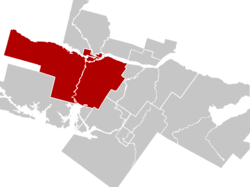Jonquière
Jonquière | |
|---|---|
 A view of Jonquière | |
 Jonquière in red | |
| Country | Canada |
| Province | Quebec |
| Region | Saguenay–Lac-Saint-Jean |
| City | Saguenay |
| Government | |
| • Borough president | Carl Dufour |
| Website | Borough Council of Jonquière |
Jonquière (/ʒɒŋˈkjɛər/; French pronunciation: [ʒɔ̃kjɛʁ]; 2021 population: 60,250)[1] is a borough (arrondissement) of the city of Saguenay in the Saguenay–Lac-Saint-Jean region of Quebec, Canada. It is located on the Saguenay River, near the borough of Chicoutimi.
History[edit]

Jonquière was founded in 1847 by Marguerite Belley, who came from La Malbaie to settle on the Rivière aux Sables. It was named after Jacques-Pierre de Taffanel de la Jonquière, Marquis de la Jonquière, governor of New France from 1749 to 1752.

Growth came from the construction of pulp and paper mills at the beginning of the 20th century. Between 1925 and 1928, the world's largest aluminum plant was built along with the city Arvida (then a separate town). In 1942, to supply power to the plant, Alcan built a hydroelectric station at Shipshaw that was the largest in the world at that time.[2] Jonquière, Arvida and Kénogami were amalgamated into the single city of Jonquière in 1975. Jonquière was the host city for the Quebec Games in the winter of 1976 and for the Canoe/Kayak World Championships in slalom and whitewater racing in 1979.
Much of Jonquière's development owed its strength to the Price family, who ran a pulp and paper factory in Kénogami. Today that factory is owned by Resolute Forest Products. Arvida is the home of an aluminium plant owned by Rio Tinto Alcan.
When the city of Saguenay was constituted on February 18, 2002 by municipal amalgamation, the borough of Jonquière was created from the former city of Jonquière, the former municipality of Shipshaw, and the former municipality of Lac-Kénogami. The former city of Jonquière had a population of 54,842 in the Canada 2001 Census, the last census in which Jonquière was counted as a separate city.[3]
The heavy metal band Voivod formed in Jonquière.
The Rivière aux Sables runs through the centre of Jonquière. Significant damage to the city's buildings was caused by the 1996 Saguenay Flood.
Transportation[edit]
Rail[edit]
Jonquière is the northern terminus of the Montreal–Jonquière passenger train operated by Via Rail. Three round-trip trains per week run between Jonquière station and Montreal Central Station, scheduled to take about nine hours each way. This route is shared by the Montreal–Senneterre train as far as Hervey station. From Montreal, passengers can connect to trains serving major destinations such as Quebec City, Ottawa, Toronto, Halifax, and New York City.
Notable people[edit]
- Christiane Chabot, artist[4]
- Bernard Jean, oboist, conductor, and music educator
- Pierre Pilote, NHL hall of famer
- Rafaël Harvey-Pinard, NHL player
- Annie Villeneuve, singer-songwriter
- Voivod, heavy metal band
- Guillaume Morissette, novelist
Mayors[edit]
- Jean Allard ( – January 20, 1868), (1872–1876) and (February 5, 1894 – August 26, 1895 Death)
- Jules Gauthier Me Jules Gauthier (1942 - bef 1949)
- Camille Gagné
- Francis Dufour (1975–1985) (Arvida 1967 – 1975)
- Gilles Marceau
- Marcel Martel ( – November 7, 1999)
- Daniel Giguère (November 7, 1999 – February 18, 2002)
References[edit]
- ^ Population calculated by combining Census Tracts 4080101.00, 4080100.00, 4080102.00, 4080103.00, 4080107.03, 4080107.04, 4080104.00, 4080110.00, 4080105.00, 4080109.00, 4080108.00, 4080107.02, 4080106.00
- ^ "Giant of the North". Popular Mechanics. 80 (6): 8. December 1943. Retrieved 10 September 2016.
- ^ 2001 Statistics Canada Community Profiles: Jonquière[permanent dead link]
- ^ "CHABOT, Christiane (born 1950), Painter, pastellist, watercolourist, sculptor : Benezit Dictionary of Artists". Oxford Index. 2011. doi:10.1093/benz/9780199773787.article.b00034871. Retrieved 14 December 2018.
External links[edit]
- (in French) Borough Council of Jonquière
- Municipality of Jonquiere (Archive)
- (in French) Municipality of Jonquiere (Archive)
- "Giant of the North" Popular Mechanics, December 1943, article on the crash program to create the Shipshaw hydroelectric project
